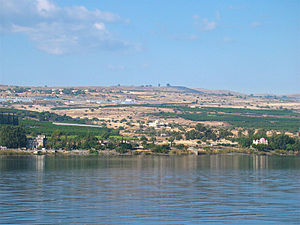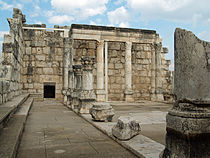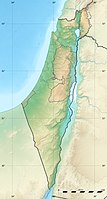 Capernaum (seen from the lake) | ||
| Capernaum | ||
| district | Northern District | |
|---|---|---|
| Residents | unknown | |
| no value for residents on Wikidata: | ||
| no tourist info on Wikidata: | ||
| location | ||
| ||
Capernaum is an archaeological site on Lake genezareth in Israel and is visited by many Christian pilgrims as the place of activity of Jesus.
background
Capernaum, also Capernaum or Kfar Nahum, Nahum village was a fishing village on the north shore of the Sea of Galilee in northern Galilee. The apostles James, John, Matthew and the brothers Simon Peter and James came from this place (Mt 4,13 ), here Jesus healed Peter's mother-in-law (Lk 4,31-39 ). The place was destroyed by an earthquake in 736, later rebuilt, but finally abandoned in the 11th century. Part of the site was acquired by the Franciscans in 1894, while another part belongs to the Orthodox Church.
getting there
Capernaum is on the road 87 on the north shore of the Sea of Galilee, the 1 Bus stop is a little northeast at the entrance to Capernaum / Kfar Nahum National Park.
The 2 western approach, the 3 east access leads to Capernaum National Park and a branch to the Greek Orthodox Apostle Church.
Tourist Attractions



archaeological site
The excavation site was acquired by the Franciscans. On it is
- 1 Peter's house
- the earliest structures include rectangular buildings of the former fishing village of Capernaum, located on the shores of the Sea of Galilee, from the 1st century; the residential area is called "Insula Sacra".
- In the fourth century, the area with the house attributed to the Apostle Peter is surrounded by a rectangular wall, the rectangular room measuring 5.8 x 6.45 m is called "Domus ecclesia", used as a Judeo-Christian meeting room. 173 plaster fragments from the walls with inscriptions attached by pilgrims, which refer to "the LORD", "the Nazarene" and "Simon", testify to the importance in early Christian times.
- in the fifth century, an octagonal basilica was built over the original building remains. In front of the octagonal building above the ruins of the house of Peter was a vestibule corresponding to half an octagon, and a baptismal font was built in the east apse.
- A new Catholic church, which was built in 1990 by the Franciscans, rises above the remains of the octagonal Byzantine basilica on stilts. The center inside the church has a glass floor through which the remains of the House of Peter below can be seen. From the outside, the walls and those of the octagonal building disappear in a peculiar way under the force of the new building.
- the 2 synagogue and Byzantine ruins. settlement
- The remains of a synagogue were also uncovered on the site of the Franciscans, which was built in Byzantine times over an older synagogue from the 3rd or 4th century. The white (brought in) limestone of the synagogue contrasts with the black basalt stones of the area and shows that the place on the Galilee border was prosperous at that time. A relief of a shrine on a four-wheeled chariot is of interest; there is speculation as to whether it is a representation of the Ark of the Covenant that was carried off to war with the Philistines.
- Between the House of Peter and the synagogue a number of other residential buildings have been uncovered. Antique vessels and an oil press can be found in the surrounding garden.
- This is in a building made of dark basalt rock 3 Franciscan convent.
More Attractions
- a little further to the east you can see the red dome of the Greek Orthodox 4 Church of the Seven Apostles, which can only be reached via a driveway starting about a kilometer further east from the main road.
- the same street also leads to 5 Capernaum National Park, in which an artists' village is to be built in addition to a restaurant and toilet facilities. There are plans to build a waterfront promenade from the grounds of the National Park past the Orthodox Church to the archaeological site at House of Peter to lead, the 3.5 km long promenade is to go to the Church of the Multiplication Tabgha to be continued.
trips
- From Capernaum it is only 2.5 km to the west 1 Tabgha, which is considered to be the place of the biblical miracle of the multiplication of the bread.
- Above Tabgha is that 2 Mount of Beatitudes, the traditional place of the Sermon on the Mount.
- A little further west of Tabgha is in the kibbutz 3 Ginnosar a fishing boat on display dating back to the 1st century BC Was dated.
- To Tiberias on the west bank of the Sea of Galilee it is approx. 15 km.











